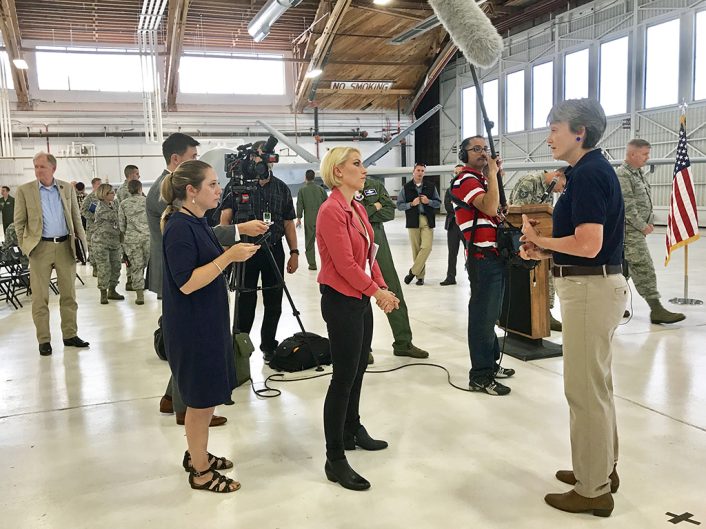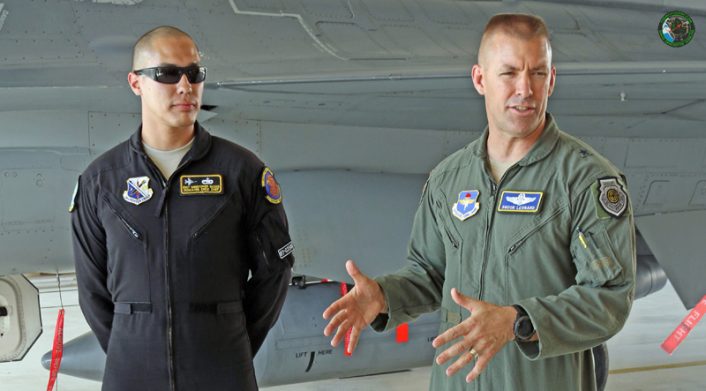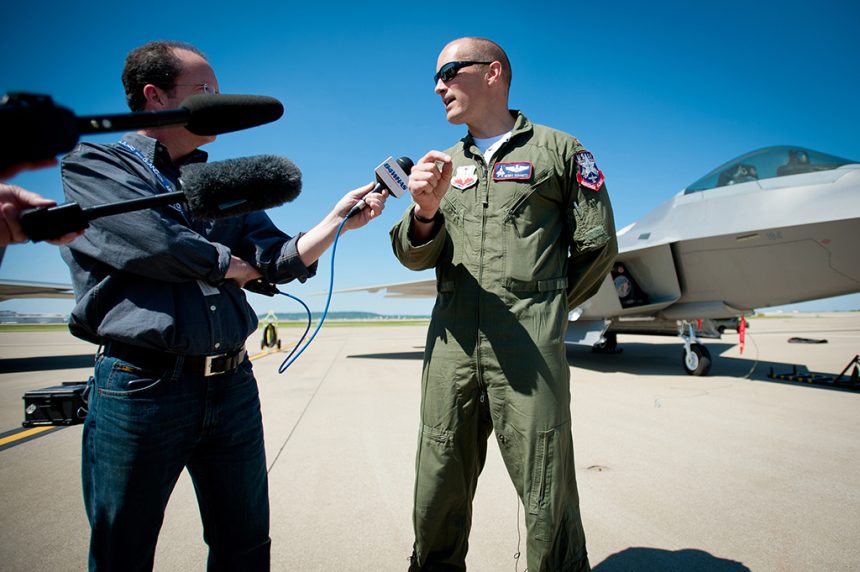Order for Retraining of Public Affairs Officers Signals Tighter Control on Reporting.
The U.S. Air Force has issued new, more controlled directives for its interaction with media reporters. The new directives may significantly limit the access journalists have to reporting on some stories about the U.S. Air Force. Officials within the U.S. Defense Department and U.S. Air Force handed down a memo on March 1, 2018 titled, “OPSEC and Public Engagement Reset” announcing new, more controlled restrictions on media reporting.
Included in the March 1 USAF Public Engagement Reset directive is the specification that, “Media embeds, media base visits and interviews are suspended until further notice.” The statement goes on to read, “Limited exceptions may be provided by SAF/PA.” (Secretary of the Air Force/Public Affairs).
The increasingly evolving defense and aerospace media relies heavily on access to military facilities and personnel to generate a wide variety of stories. Storylines, like the ones you read here on The Aviationist.com, range from public interest stories that inspire young people to pursue a military career to military technology, reporting on news about training and operations and stories about historical topics.
The U.S. Air Force and other military services work in cooperation with media outlets to provide access to bases, training areas and personnel for the purpose of generating news stories in promotion of military doctrine and in compliance with the U.S. Constitution’s First Amendment that guarantees freedom of the press.
Journalists who report on U.S. Air Force subjects have, in general, voluntarily maintained a balanced relationship between maintaining operational security in the interest of overall national security and bringing news stories to the public audience. Reporters know that if they intentionally or inadvertently report on a topic that violates or presses the limits of maintaining operational security (OPSEC) their access will be revoked and they may create a potentially dangerous circumstance putting U.S. service members and defense initiatives at risk. For all defense journalists, maintaining the balance between operational security and freedom of speech in reporting is a significant responsibility and delicate balancing act.

The reasons for this March 1, 2018 change in media directives for the U.S. Air Force could be multi-fold.
During the last decade defense media has evolved and expanded significantly to include vastly greater numbers of media outlets. The quality and credibility of the outlets range from casual social media to major international network news media. Since the onset of media proliferation most of the military services at the national level have done little to adapt their media services to work safely and effectively with the greater number and scale of media outlets. As a result, some public affairs operations have had greatly increased workloads with little strategic direction set against the backdrop of the evolution in media. For the most part, the system has worked well, but the two entities occasionally must moderate the sometimes-conflicting motives of the media to release compelling stories and the Air Force to maintain security. One example was the September, 2017 fatal accident of U.S. Air Force pilot Lt. Col. Eric Schultz.
Lt. Col. Schultz’s remarkable career eventually led to his involvement in classified operations over the vast Nellis Ranges in Nevada. When he died in an accident on September 5, 2017 popular aviation media was rife with speculation about what Lt. Col. Schultz’s mission may have been at the time. Some outlets questioned if Lt. Col. Schultz’s death was being kept classified to protect specific air force programs from criticism. The Air Force was quick to issue media statements from the command level dispelling those theories.
Another reason for changes in Air Force public relations may be more sensational. Several new key technologies may be reaching a level of maturity that mandates a reset of security to protect them from being compromised. The Air Force and aerospace contractors have been selectively public in their disclosures about major programs like the new Long Range Strike-Bomber (LRS-B). But as more media outlets across the entire spectrum press harder and harder for a “scoop” the necessary operational security surrounding these programs becomes more difficult to maintain.
Finally, another contributing factor to the change in Air Force media policy may be that the current internal system is simply overloaded. Given the increase in media outlets and growth in public interest and new story lines the current Air Force public affairs system is trying to sip water from a fire hose. There are simply too many media outlets, reporters asking for access and stories and too few Air Force public affairs personnel to moderate the exploding demand for media against the very real need to maintain operational security while ensuring the media outlets are producing quality media.
This new media restriction couldn’t come at a worse time for the Air Force from a recruiting perspective. A central problem facing the U.S. Air Force is a critical pilot shortage. While there may be no quick fix for producing proficient new Air Force pilots a reduction in the volume of inspiring media about Air Force careers will not help drive new officers and airmen to join the Air Force.

An embarrassing incident on social media from January, 2018 at Nellis AFB in Nevada was also highlighted in the news earlier this year. USAF Tech. Sgt. Geraldine Lovely of the 99th Force Support Squadron at Nellis posted derogatory comments about subordinates on a social media platform. Here angry remarks, that included profanity and racial slurs, were viewed by over 1 million people and shared over 8,000 times. Tech. Sgt. Lovely was subsequently disciplined and in-service training for the use of social media by Air Force personnel was initiated in response to the incident.
If there is a singular theme to this story it is that media and stories have expanded and changed faster than Air Force public relations capabilities. This, set against a backdrop of what may be some emerging (and exciting) new technologies for the Air Force has caused the story faucet to be turned off. Now it is up to reporters to figure out innovative ways to quench readers’ thirst for Air Force news in this new information draught.
Top image: News reporters interview Maj. Henry Schantz, commander of the U.S. Air Force F-22 Raptor Demonstration Team, at the Kentucky Air National Guard Base in Louisville, Ky., on April 18, 2012. Schantz, who is based at Langley Air Force Base, Va., will be piloting the F-22 in Louisville’s 22nd annual Thunder Over Louisville air show, to be held along the banks of the Ohio River on April 21. The Raptor is the U.S. military’s premier fighter aircraft, with capabilities that are unmatched by any other plane. (U.S. Air Force Photo by Maj. Dale Greer)









